|
|
|
Monday, October 28th, 2019
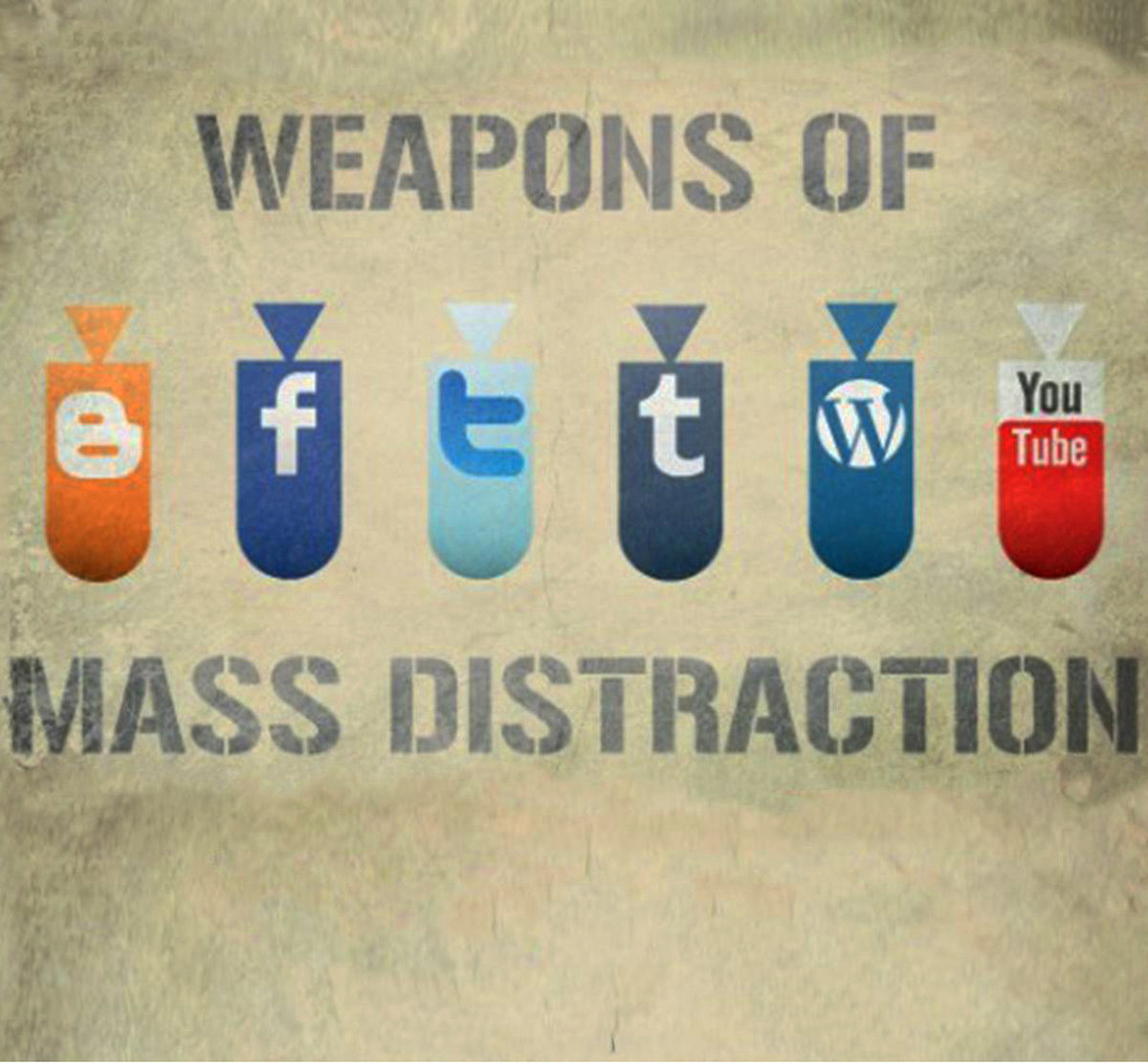
Poking through 13+ years of posts I find information that’s as useful now as when it was written.
Golden Oldies is a collection of the most relevant and timeless posts during that time.
Since this was written in 2012 things have gotten much worse, with deep fakes, audio and video, fake news and misinformation in general added to everything described in the post. Caveat emptor (let the buyer beware) is more true now and more important than ever before.
Read other Golden Oldies here.
Do you look for peer reviews, such as those on Yelp, Amazon and most consumer sites, before buying the product, visiting the restaurant or booking the hotel?
Before the Internet we asked our friends and checked critics’ comments in newspapers and magazines, in order to increase the odds for a favorable experience.
These days we check the Internet.
“The wheels of online commerce run on positive reviews,” said Bing Liu, a data-mining expert at the University of Illinois, Chicago (…) Mr. Liu estimates that about one-third of all consumer reviews on the Internet are fake.
Consumer reviews are powerful because, unlike old-style advertising and marketing, they offer the illusion of truth. They purport to be testimonials of real people, even though some are bought and sold just like everything else on the commercial Internet.
Do rankings based on the number of followers people have influence your trust level or opinion of them? But how do you know they are real?
And it’s not just ego-driven blogger types. Celebrities, politicians, start-ups, aspiring rock stars, reality show hopefuls — anyone who might benefit from having a larger social media footprint — are known to have bought large blocks of Twitter followers.
Are you impressed when someone’s Facebook wall is filled with beautiful people?
They are for sale, too.
His idea, he said, was “to turn cyberlosers into social-networking magnets” by providing fictitious postings from attractive people. The postings are written by the client or by Mr. Walker and his employees, who base the messages on the client’s requests.
If having to choose between being a chump and a cynic isn’t up your alley, perhaps the best advice when it comes to reviews, followers and friends is ‘buyer beware’ and ‘if it seems to good to be true it probably is’.
Flickr image credit: Psychology Today
Posted in Communication, Golden Oldies, Personal Growth | No Comments »
Tuesday, April 30th, 2019
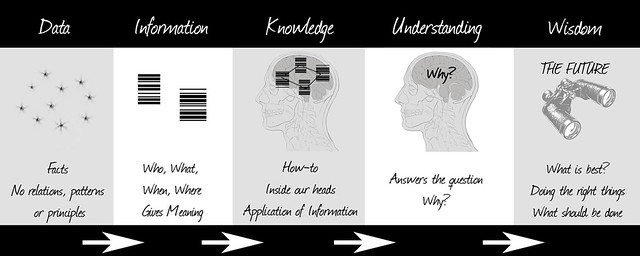
The above image was yesterday’s Oldie from 2009.
What’s changed (or was off in the first place) since then?
Let’s take them one-by-one.
Data: data, since “facts” are often historical and the historical info is often biased.
Information: Think bias and fake news, neither is new, but the quantity has exploded.
Knowledge: Same as original.
Understanding: Too often why or any questioning is asked only if the facts and information run counter to our beliefs, opinion, and worldview.
Wisdom: Unlikely.
Wikipedia describes wisdom as follows:
Wisdom, sapience, or sagacity is the ability to think and act using knowledge, experience, understanding, common sense and insight.[1] Wisdom is associated with attributes such as unbiased judgment, compassion, experiential self-knowledge, self-transcendence and non-attachment,[2] and virtues such as ethics and benevolence.[3][4]
Much of the ability to think according to the above description has been either voluntarily turned over to, or co-opted by, social media.
Considered actions often must pass an “Instagram/Twitter filter;” those that don’t aren’t acted upon.
If there is anything social media can not be blamed for it’s a proliferation of wisdom.
Join me tomorrow for a look at ways and means to acquire wisdom.
Image credit: Nick J Webb
Posted in Ducks In A Row, Personal Growth | No Comments »
Wednesday, April 3rd, 2019
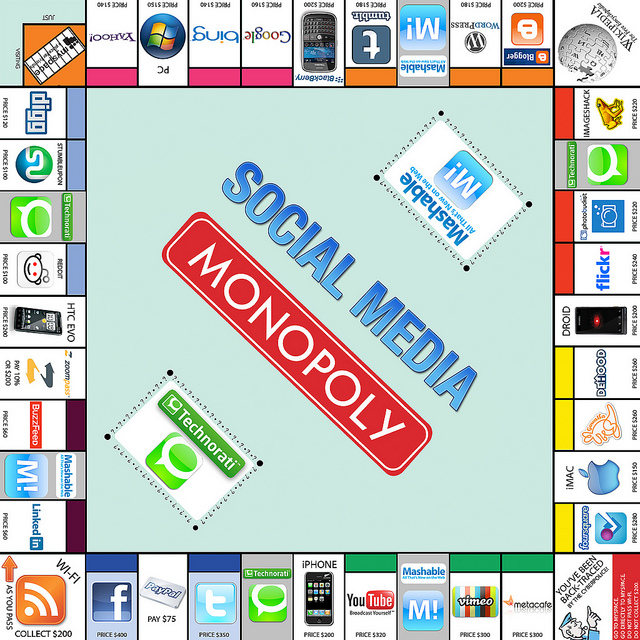
“Change is the only constant” is an oft-quoted idea first uttered around 500 BC by Heraclitus, a Greek philosopher (those Greeks really knew what they were talking about).
The only difference between then and now is that change happens a whole lot faster.
In these days of fast change I try to keep two rules firmly in my conscious mind.
The first is something I heard many years ago, although don’t remember where.
The only thing free is the cheese in the mouse trap.
For whatever reason it really sank in and proved to be protection, preventing me from falling for the lure of free as social media, Google and other services rose to overwhelming prominence.
It kept me from being parsed, productized, and sold.
The second isn’t new and has been said many ways over the decades. This is how I’ve thought about it for decades.
Personality reaps more acclaim than talent or accomplishments.
I find it especially true in these days of personal branding and self promotion.
I’m grateful I absorbed both ideas; they’ve made my life much simpler, safer and easier these days.
And I’m not missing a thing.
Image credit: Cambodia4kids.org Beth Kanter
Posted in Miki's Rules to Live by | No Comments »
Tuesday, April 2nd, 2019
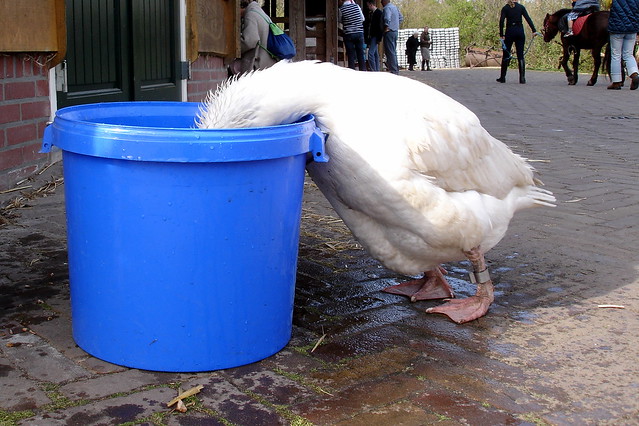
There was a time that having influence meant something.
Maybe it still does in certain circles, but for much of the world it means you have millions, or at least hundreds of thousands, of followers on Instagram, YouTube and Twitter (Facebook seems to be passé).
They are called ‘influencers’ and their followers treat their words, actions, recommendations, and opinions as gospel.
In spite of the fact that many of them are paid to promote [whatever].
Of course, famous people have been paid to endorse products for decades.
The difference is that many influencers are famous only because they are expert manipulators of social media — or they pay experts to build their brand.
So. Not new and relatively harmless.
But not when they are built on a lie and involve your health or money.
[Yovana Mendoza] The 28-year-old influencer, also known as Rawvana, has amassed more than 3 million followers across YouTube and Instagram by extolling the life-changing properties of a raw vegan diet. (…) a couple of weeks ago, Mendoza was recorded eating seafood (…) Realising she was being filmed, she tried to hide the fish, but the jig was up.
Mendoza admitted she had stopped eating vegan for health reasons.
But she kept preaching the lifestyle.
There are dozens of similar stories and hundreds of influencers whose only true skill is self-promotion.
They talk about health; about money; about “living your best life.”
They talk to the millions of fools who follow them.
Image credit: Marco Raaphorst
Posted in Communication, Culture, Ducks In A Row | No Comments »
Friday, October 19th, 2018
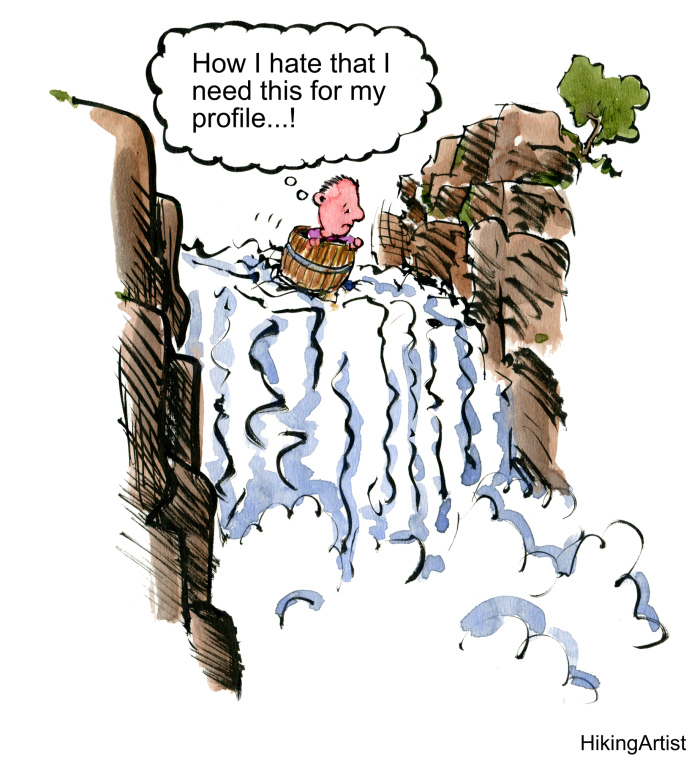
I’ve used stuff from Frits Ahlefeldt many times over the years; he does amazing cartoons, illustrations and art.
Better than anything I could say are Frits’ own words.
Drawing and wondering about how the need for personal online branding on places like Facebook and Twitter more and more influence the experiences and challenges people choose, because they are all part of a personal media / branding strategy.
This guy took it all the way:
Image credit: HikingArtist
Posted in Personal Growth | No Comments »
Tuesday, September 4th, 2018
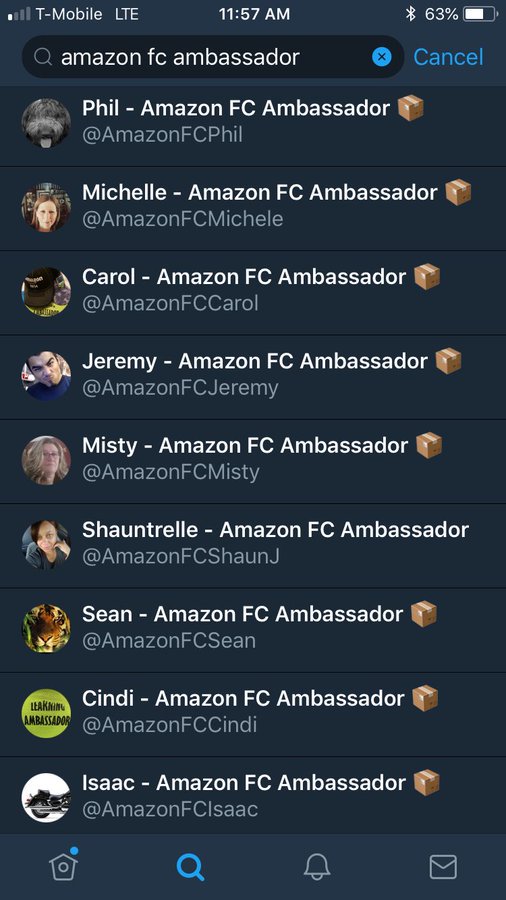
Bezos may be a genius and Amazon may be beloved by it’s customers, but for years it has been reviled for it’s (mis)treatment of fulfillment center (AKA, warehouse) workers.
The newest weapon in it’s fight to correct the facts is a Twitter campaign.
“FC ambassadors are employees who have experience working in our fulfillment centers… The most important thing is that they’ve been here long enough to honestly share the facts based on personal experience.”
The effort was first outed by Flamboyant Shoes Guy, who also said in a comment,
What amazes me is that a entire board of people on 7 or 8-figure salaries had several meetings regarding this, discussed it thoroughly and then concluded that there was no way anyone could possibly notice.
But if you think warehouse conditions are bad now, when the economy is hot and bodies in short supply, just wait until it turns, as it will. (What goes up always comes down. It’s the nature of the beast.)
Be it Amazon, Google, Facebook, Apple, etc., you need to remember that companies, just like people, aren’t all good or all bad.
It’s just that their bad has a much larger effect.
Image credit: Twitter
Posted in Communication, Culture, Ducks In A Row | No Comments »
Tuesday, June 19th, 2018
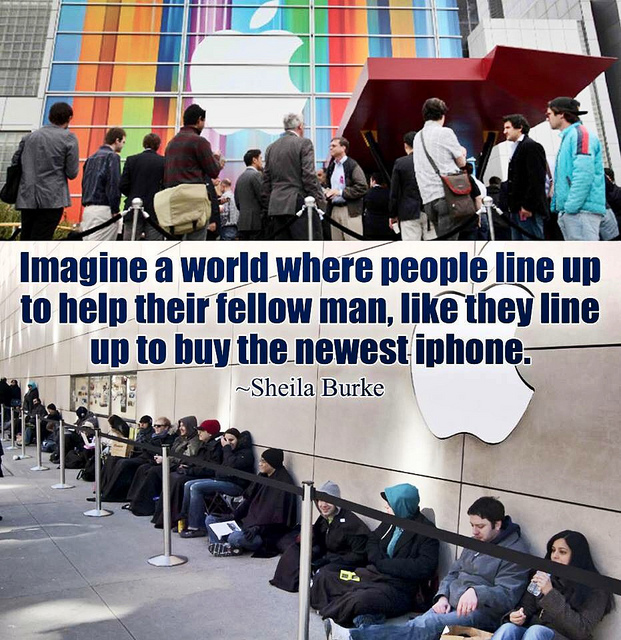
In yesterday’s Golden Oldie I referred to the importance of noticing and touching “just one life,” as opposed to fixing the world.
It’s been just shy of a decade since I wrote it, so it’s worth asking.
How many lives have you touched? How many times have you, as Anne Herbert says, practiced random acts of kindness of senseless acts of beauty?
Let alone done it anonymously — no Twitter bragging, Instagram image or Facebook post?
For that matter, when did you last look up from your phone long enough to notice the opportunity to do either?
Image credit: Lion Multimedia Production U.S.A.
Posted in Personal Growth | No Comments »
Thursday, June 7th, 2018
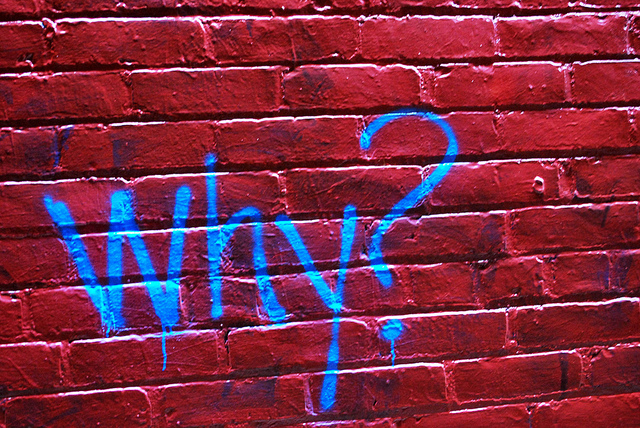
I wrote a piece last week on the idea of embracing the rush of our lives and how it’s a human condition. While to some degree I do think it’s a sign of our times and not altogether negative, I do see the impact it has made.
In school I read about the effects of coffee on the industrial revolution. The idea was that the widespread use of the stimulant allowed shift workers to operate all hours of the day and night.
Of course, we, in the modern day, have benefited on the backs of their labor; however, we have also learned from the negative aspects of that society. At least in this country, we no longer employ children, we have tougher safety laws, and regulation.
Back to my point of embracing rushing, I was wrong to take it on from a single standpoint. Through this past week I have searched out resources to learn more about the effects of our gadget driven world and what it has gotten us.
I titled this post “Start with why” and it’s a rip off from a great book of the same name by Simon Sinek.
That book focuses on sales and challenges sales people to start by asking why someone would want to buy their product/service and then shape a solution around that.
However, he also speaks about the current state of our society and it’s character.
If we could sum up the modern First World in one word it would be addiction and not just to drugs.
Many in my generation are addicted to our phones, our streaming services and our reliance on same day delivery. We can order anything, watch any show and contact any person in the world. In an odd twist of fate I can get live tweets from our current president and tweet him back.
As a current digital addict I tend to look at others and see it as normal.
When I am at the park I tend to not use my phone and see that others are. As a result I figure I must be balanced.
However, first thing in the morning I check my phone and look at my notifications. If you were to follow me on a social network you would see that I don’t post a ton. In reality I tend to not think I have much to say that is important for the world to know and I limit my posts for food recommendations while in new cities.
However, I check all the networks multiple times a day. I get updated on the latest coffee from the person I had 10th grade English with and also get to see the latest from our President.
It’s an odd time to be alive.
Why do we do this?
One reason is dopamine. It is the same drug that opiates release and it’s triggered naturally when we see activities or people responding to our posts. That’s why we look to see the comments, the likes and the re-shares.
It’s also why we tend to get worse over time with our usage. We need more and more dopamine to feel good.
I wrote all of this to say one thing.
Maybe we shouldn’t always embrace the rushing and start with the why.
Why are we doing this; who do we care about; why are we not happy.
Image credit: Ksayer1
Posted in Personal Growth, Ryan's Journal | 1 Comment »
Monday, June 4th, 2018
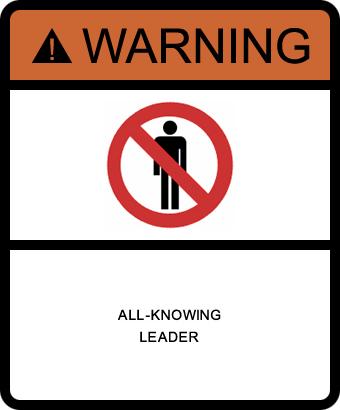
Poking through 11+ years of posts I find information that’s as useful now as when it was written.
Golden Oldies is a collection of the most relevant and timeless posts during that time.
I came across these two posts several weeks apart. The ideas they presented seemed to logically follow each other. This is strange only because the first one shown was written in 2013 and the following post in 2009.
Regarding the actual content, it’s still valid, only more so.
Read other Golden Oldies here.
Three Categories of People
People have longed for an all-knowing leader who they can mindlessly follow and abdicate their decision-making, since time began.
Some seek this all-knowing leader in religion; others look to politics, while still others believe that business is a better source.
Their time would be better spent accepting the reality that no such thing exists anywhere in any walk of life.
Then there are the people who aspire to be that all-knowing leader.
To that end they amass thousands of friends and followers, network their way well beyond what’s needed to be a LinkedIn Lion and work ceaselessly to raise their Klout score.
Finally, there are those who know without doubt that all-knowing leaders are in the same category as the tooth fairy, Easter Bunny and Santa Clause.
Which are you?
Follow Yourself; Partner With Others
I have a great idea to make the world a better place.
- Everybody who aspires to the cult of all-knowing leader stops.
- Everybody who longs for an all-knowing leader embraces the reality that no such thing exists.
Replacing these, everybody would
- learn leadership skills;
- apply them constantly to themselves; and
- occasionally in the outside world as circumstances dictated;
- take responsibility for their own actions and decisions; and
- partner with others as equals, whether one was in front or behind at any given time.
Not that I think there’s a chance in hell that this will happen, but it’s a nice thought on a beautiful summer Friday.
Image credit: Warning Sign Generator
Posted in Golden Oldies, Leadership, Personal Growth | No Comments »
Tuesday, February 13th, 2018
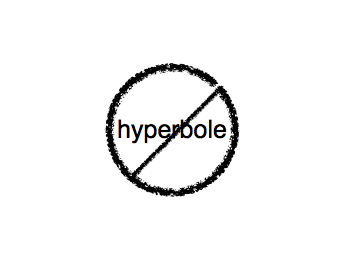 Fake news. People everywhere in the US and in all walks of life are talking about it. Fake news. People everywhere in the US and in all walks of life are talking about it.
There’s no question that fake news is subversive, whether created by humans or driven by AI.
But what about unfake fake news as served up by mainstream and new media alike?
Think you’ve never seen it?
Sure you have.
Frequently in financial reporting.
From CNBC: Twitter rockets more than 20 percent after the company reports first-ever net profit.
From BI: Snap crushed Wall Street’s revenue targets in its fourth quarter, as it filled its Snapchat app with more ads than ever and tapped into a broader group of consumers.
From US News: Tesla Finally Gives Investors Good Earnings News.
Wow! Based on the above headlines they look like great bets to contribute to your retirement.
Maybe.
But before investing your hard-earned dollars you might want to see what the same information looks like sans spin, hype and OMG.
Consider the information, often buried in euphoric media hyperbole, kind of like the fine print in a warranty or lease.
From Recode: Achieving profitability was one of the company’s [Twitter] main goals in 2017, and one of the big reasons it laid off 9 percent of its workforce in late 2016, and then sold off its developer business and shut down its video app Vine. Investors like profitable companies, and so do potential acquirers.
From TechCrunch: Snapchat’s big redesign will reach all users during Q1 2018, up from 40 million users currently. It was due to be fully rolled out by now but that has been delayed following poor reception in countries like the U.K., Australia and Canada. Amongst some of the first users to review the update, 83 percent of App Store reviews were negative, citing a confusing interface, ads mixed into the message inbox via Stories and people who don’t follow you back getting pushed into the Discover section.
From the New York times: The company [Tesla] lost $1.96 billion for the full year of 2017, nearly three times its loss of $675 million in 2016. The company has never made a full-year profit since it went public in 2010.
So what would unfake/unspun headlines look like?
KG sent along some hilariously accurate examples.
Caveat emptor, indeed.
Image credit: Kate Mereand-Sinha
Posted in Communication | No Comments »
|
 Subscribe to
Subscribe to
MAPping Company Success
About Miki 
Clarify your exec summary, website, etc.
Have a quick question or just want to chat? Feel free to write or call me at 360.335.8054
The 12 Ingredients of a Fillable Req
CheatSheet for InterviewERS
CheatSheet for InterviewEEs™
Give your mind a rest. Here are 4 quick ways to get rid of kinks, break a logjam or juice your creativity!
Creative mousing
Bubblewrap!
Animal innovation
Brain teaser
The latest disaster is here at home; donate to the East Coast recovery efforts now!
Text REDCROSS to 90999 to make a $10 donation or call 00.733.2767. $10 really really does make a difference and you'll never miss it.
And always donate what you can whenever you can
The following accept cash and in-kind donations: Doctors Without Borders, UNICEF, Red Cross, World Food Program, Save the Children
*/
?>About Miki
About KG
Clarify your exec summary, website, marketing collateral, etc.
Have a question or just want to chat @ no cost? Feel free to write
Download useful assistance now.
Entrepreneurs face difficulties that are hard for most people to imagine, let alone understand. You can find anonymous help and connections that do understand at 7 cups of tea.
Crises never end.
$10 really does make a difference and you’ll never miss it,
while $10 a month has exponential power.
Always donate what you can whenever you can.
The following accept cash and in-kind donations:
|















